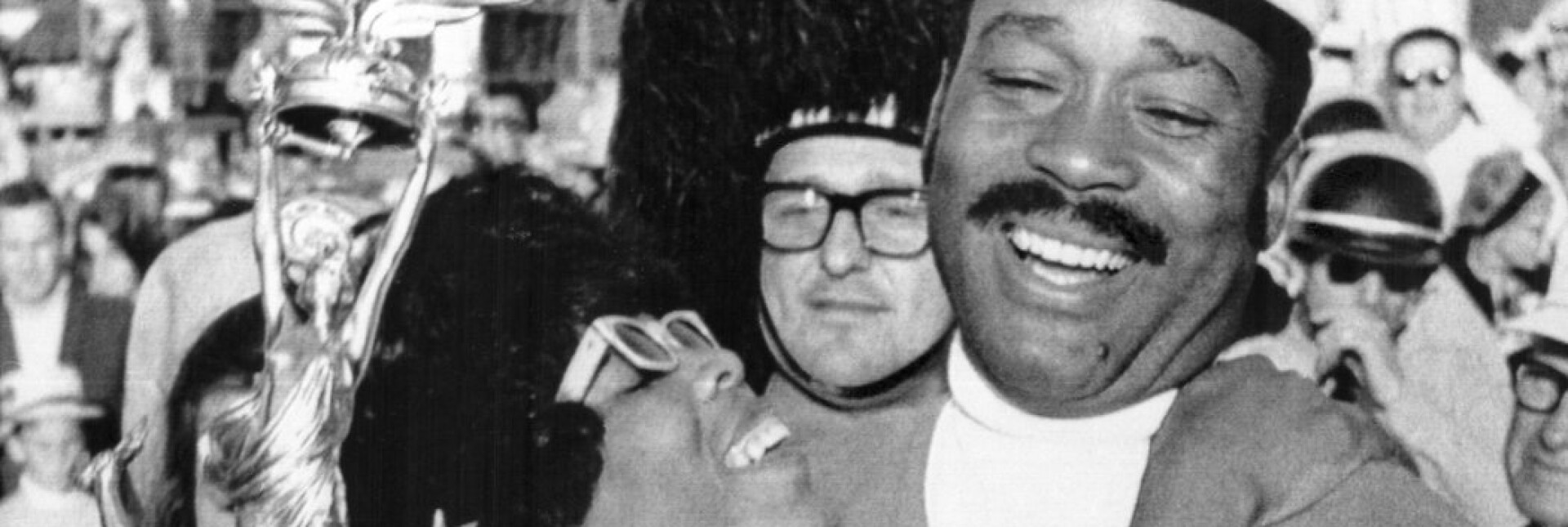The late Pete Brown, who made history often in his 50-year professional golf career, didn’t make a big fuss about much of anything.
Bob Goalby, the 1968 Masters Champion, said of his friend, “Pete didn’t let anything bother him, not getting too high or too low.”
That trait served Brown well as a Black professional golfer from the Deep South. According to his wife, Margaret, Pete often said, “Laugh at ‘em and keep going.”
He was born in 1935, in Port Gibson, Mississippi, into a family of sharecroppers. His father, George, was a Baptist minister.
As a youngster, Pete chopped cotton and picked peas. The family moved to Jackson when he was 10 and he soon gravitated to the Livingston Park golf course where he became a caddie, making 35 cents for nine holes and 55 cents for 18.
Blacks were not allowed to play that course or any in the city, but at night Brown said he and the other caddies would sneak out and play a few holes near the woods until they were chased off.
At age 19, Brown was stricken with polio; he spent a year in Herman Kiefer Hospital in Detroit, where his weight plummeted from 176 to 100 pounds. Doctors advised him to think about an activity other than golf. Brown slowly recovered, inspired by hospital visitors that included tour professional Charlie Sifford and boxing legend Joe Louis.
Brown competed in the 1950s on what was called the “Chitlin Circuit.” He captured four Negro National Opens and three North & South Championships before earning his PGA Tour card in 1963.
In 1964, Brown rallied to win the Waco Turner Open in Burneyville, Oklahoma. Also that year, he became the first Black to compete in the PGA Championship: He tied for 33rd at Columbus (Ohio) Country Club.
While Brown was winning in Oklahoma, Margaret was in Los Angeles, pregnant with their youngest of six daughters, Tracie. That evening, after a one-stroke victory over Dan Sikes, he called her from his hotel room.
“Well, I won a tournament for you and I want to see the kids,” said Pete.
It took a long time for that to sink in.
“That’s wonderful,” said Margaret. “Quit lying to me.
“No, I won the tournament,” said Pete. “I made history.”
Now 80, Margaret lives with Tracie, a social worker, in Dayton, Ohio, where she moved after Pete died of congestive heart failure in 2015.
Margaret said that there was one thing that ruffled her husband: his birth name, Earlie.
He hated it so much that, around age seven, he changed his name to Pete—in honor of a pet horse with the same name.
Dealing with Racism
Brown spent much of his career deflecting hatred and racism. During a tournament in Florida, he slept in his car because of threats from the Ku Klux Klan.
Playing in Ohio, he stepped outside the ropes to buy a hot dog; coming back, a marshal refused to let him back across the rope until fellow professional Tom Weiskopf came over.
Perhaps the defining example of Brown’s overcoming hate came in the 1962 Michigan Open at Farmington Country Club, a course that doesn’t exist anymore.
It was only a year after the Caucasian-only clause was eradicated from PGA of America Bylaws, and the first year that Blacks were allowed in the event. Brown had posted a final-round 68 and was about to sip a beer with friends in the Farmington clubhouse when he was suddenly summoned to the first tee for a playoff with Tom Talkington Sr.
“I was at the tee and Pete was to hit second,” said Margaret. “So [Talkington] hits first and Pete steps up to put his tee in the ground and adjust his ball. Just then, from across the fence, I could see young men by a pickup truck. One of them yells, ‘Hey (N-word)! What are YOU doing up there?’
“Well, there were people all around the tee and everyone got so quiet you could have heard a pin drop. Everybody just froze. Pete just backed off the ball, tossed his club on the ground and … started laughing.
The crowd, Margaret said, “was like ‘OK, we can breathe again.’ And they started laughing and now everybody was pulling for Pete. He steps back up and knocks that ball right down the fairway and goes on to win the tournament. I remember people at the tee, muttering, ‘What a man, what a man!”
But there was more.
Margaret didn’t walk to the first green of the playoff. Those same hecklers traveled down the road adjacent to the first fairway. Talkington had chipped to within a few feet to assure himself a par. Brown had hit his approach to within 10 feet and was facing a winning birdie putt.
“Hey, [N-word], what are you doing?” the same hateful voice broke the honored silence afforded all golfers preparing a stroke.
In his 2005 book, “A Course of Their Own, A History of African American Golfers,” author John H. Kennedy recounted how the heckler and his friends then drove off. Brown shook his head, regrouped and missed the putt.
The playoff went to the par-3 third hole, where Talkington missed a par putt. Brown grabbed victory by sinking an eight-foot downhill par putt that spun around the hole and dropped into the cup.
Talkington, who passed away in 2015, once told his son, Tom Jr., now a PGA Professional in Jackson, Tennessee, “Pete was a fine player and a good guy. That day, I didn’t expect to make history by losing.”
‘One of the Nicest Men Alive’
Sheila Brown, the second youngest of Browns’ six daughters, was just six years old when she planted herself in front of the television and yelled for all her family to join her. Margaret remembered being in the living room in time to see Pete on the screen and striding toward the green. Sheila asked everyone to be quiet, and to let the announcer speak.
“Here comes Pete Brown, one of the nicest men alive.”
“Hey momma,” said Sheila, “why do they always say, Daddy is the nicest man alive? Aren’t all the other golfers nice?”
Margaret was taken aback. “I couldn’t think of anything at the moment, so I blurted out, ‘Sure they are, honey. But your daddy has that sneaky smile that wins your heart.’” With that explanation, Sheila was satisfied and skipped out the door.
Sheila and Brown's oldest daughter, Pamela, passed away in 2005 and 2009, respectively.
Brown was at the zenith of his career in 1970, winning one more Tour event, the Andy Williams San Diego Open. He defeated Tony Jacklin in a playoff. Jack Nicklaus finished a stroke out of joining the twosome.
A year later, former PGA Tour official Wade Cagle was in San Diego, where Brown was defending his title. Cagle grabbed the microphone and announced, “Now on the tee, Mr. Earlie Brown.”
“Pete just sat by his bag, frowning, and had to be coaxed to go to the tee,” said Margaret. “He said, ‘I heard someone call Earlie Brown. My name is Pete.’ ”
Despite his 1970 Tour victory in San Diego, Brown didn’t get an invitation to The Masters just as his longtime friend, Charlie Sifford, hadn’t in 1967 or ’69 when he won tour events. In those days, tour winners didn’t get automatic invitations.
“Before I won (in 1964), they were tournament winners,” Brown said to Scott Michaux of the Augusta Chronicle in 2012. “And when I won, they changed the rules. They had a kind of points system, like they do now with the FedEx Cup. I always played good before Florida but never played good in Florida or I would have made it. At the time, if you played well the former champions could invite a player they thought played good enough to be invited to the Masters. The thing about it is, the Masters sent out a list of players they wanted them to vote on. That was another stumbling block because if your name wasn’t on that list, you didn’t play anyway. It was fine.”
Pete made 365 career starts on the PGA Tour and earned $214,413. When back pain began forcing him out of tournaments, he began running a driving range in Los Angeles.
Making a Home in Augusta, Still Making History
A year after a fire destroyed the Brown’s home – including Pete’s trophy room – he took a job running Madden Golf Course in Dayton. Margaret ran the restaurant and for 24 years the course was home.
Recurring health issues hastened Pete’s retirement in 2004. Later, fellow Black Tour Professional Jim Dent – who Pete had taken under his wing – offered the Browns his second home, rent free, in Evans, Georgia, outside Augusta,
“Pete showed me the ropes when I was just starting on Tour,” said Dent. “He was my mentor and the man who was key to my career. You do what you can to help your friend, and I was happy that he and his wife could be down here with me for as long as they wanted.”
According to Margaret, Pete survived an amazing 14 strokes but never suffered paralysis.
“One year, Pete was told that surgery couldn’t be performed because they were afraid he would never survive it,” said Margaret. “Pete said, ‘Oh, come on. Let’s go for it.’ The doctor looked at me, and I said, ‘Well, I’m headed to a little room and do some praying.’ Pete survived that to live several more years. After that surgery, the nurses and doctors called him ‘The Miracle Man.’”
In 2019, Jackson Municipal Golf Course was renamed the Pete Brown Golf Facility. Today, nearly six years after his death, he is making history again, as part of the 2020 induction class to the Mississippi Sports Hall of Fame. The enshrinement ceremony has been indefinitely delayed due to the pandemic. Margaret said once the arrangements are worked out, she’ll be there.
“He’s their first African-American golfer,” said Margaret. “I was talking to one of our daughters a while back and she said, ‘Daddy sure made a lot of history, didn’t he?’ ”




